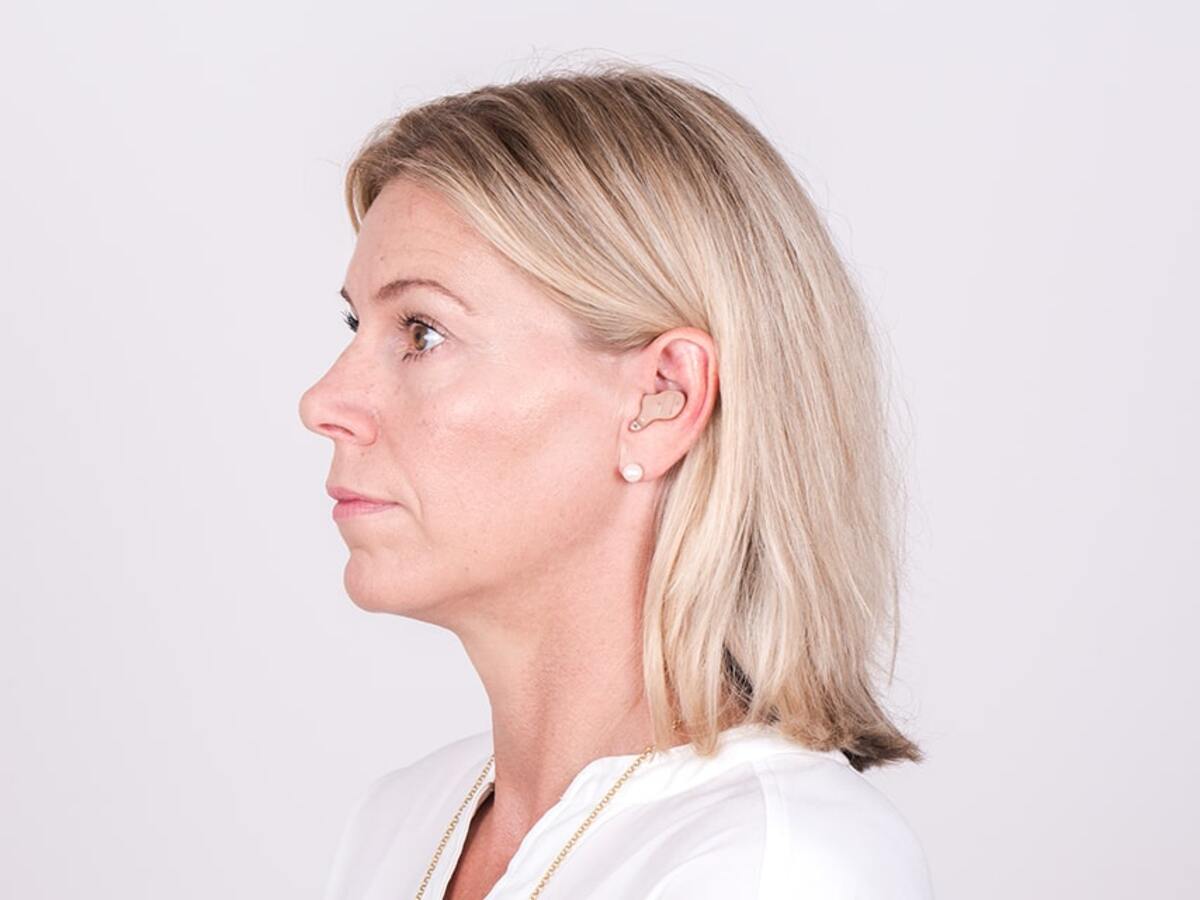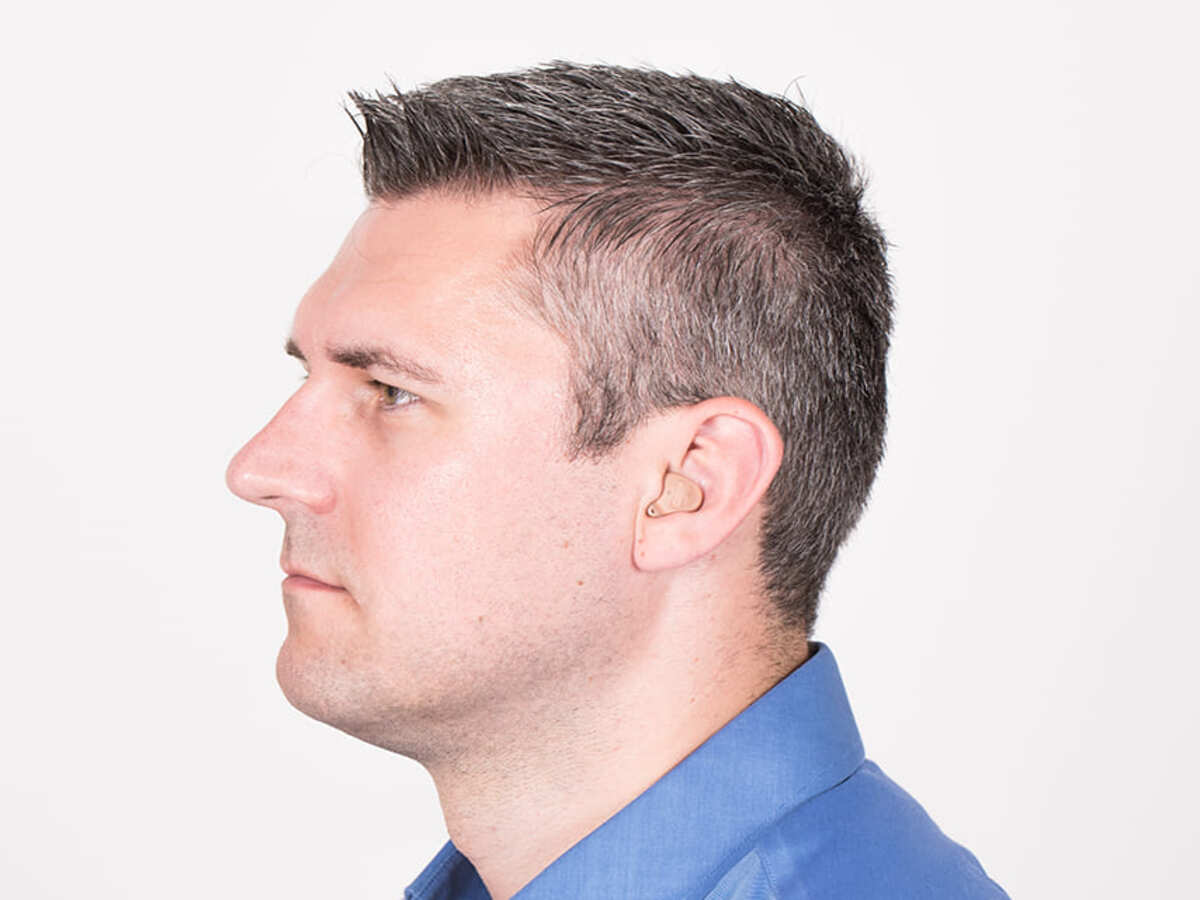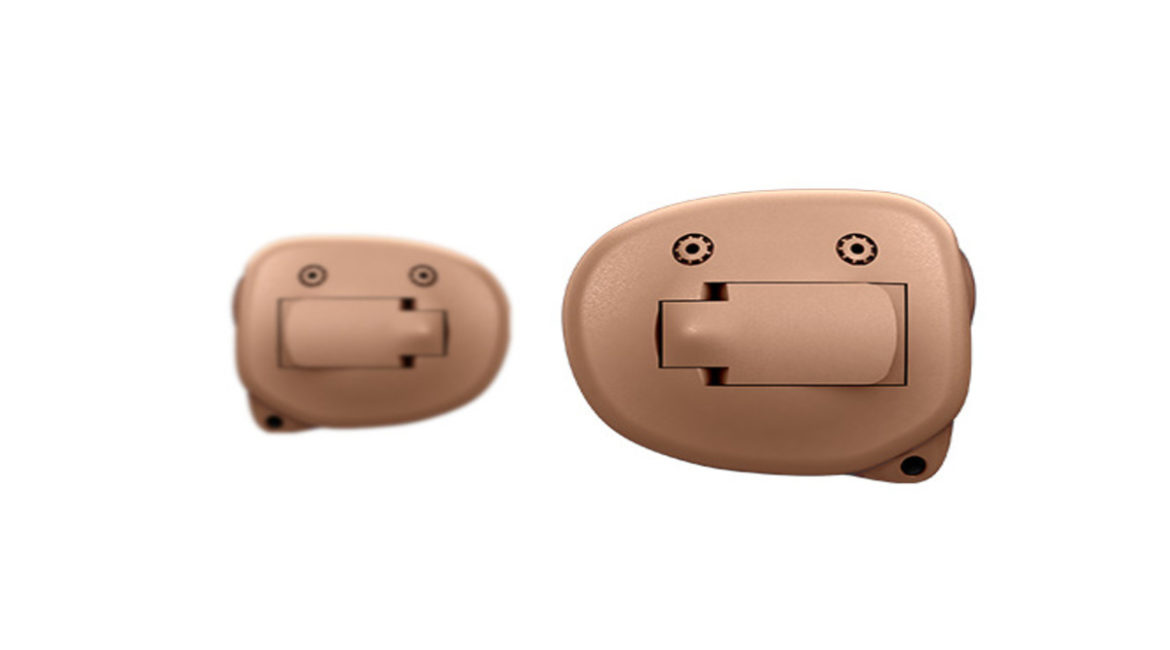Image via bernafon.com
One of the most discreet hearing aid styles is the in-the-ear or ITE hearing aid. In contrast to behind-the-ear hearing aids, this type has no visible external cables or tubes. All ITE hearing aids are created to assure a precise fit and an unobtrusive appearance.
When you choose an ITE hearing aid, the hearing care professional will take an imprint or scan the interior of the hearing aid user’s ear to ensure a custom fit. This process is important because it ensures that the hearing aid will be comfortable to wear and that it will not cause any irritation.
In addition, a custom fit also helps to improve the sound quality of the hearing aid by preventing outside noise from leaking in.
Small Visible Hearing Aids
As the name suggests, in the ear or ITE hearing aids rest inside the ear. They do not reach as deep as invisible in the canal devices, but rather sit on the very edge of the ear canal.
They’re designed using a custom mould made to fit your ear shape and come with a twin microphone design that improves their general sound quality and amplification potential.
Full-shell or half-shell ITE hearing aids are available. Half-shell patterns are smaller and consequently more inconspicuous than full-shell designs, which cover more of the ear bowl.
The Difference Between ITC and ITE Hearing Aids
Hearing aids that are worn in the canal are among the most unobtrusive, whereas ITE devices are worn in the outer ear bowl. Many people are unaware that there is a distinction between the two because they are both worn in the ear.
The Benefits of ITE Hearing Aids
ITE hearing aids are considered to be one of the best types of hearing aids on the market. They are small and discreet, making them perfect for those who want a low-profile device. Here are some of the other benefits of using ITE hearing aids.
Superior Sound Quality and Amplification
ITE hearing aids include dual microphones, which means they generate superior sound quality and amplification in general. As a result, they’re better suited to people who have moderate to severe hearing loss because people with profound hearing loss require a hearing aid that is free from background noise.
Inconspicuous and Recessed
They’re also more inconspicuous than BTE hearing devices because they’re smaller and fit within the ear. They’re also recessed, so they’re less likely to get in the way when you’re talking on the phone or using a headset.
Always Fit
Finally, they’re largely regarded as the most pleasant of all the hearing aids available. After all, they’re made from a mould of your own ear, so they’ll always fit properly.
The Disadvantages of ITE Hearing Aids
For the elderly and those with hearing loss, using an ITE hearing aid is often the best solution. However, there are a few disadvantages to using ITE hearing aids that should be considered.
Require Frequent Cleaning
ITE devices tend to draw more ear wax, dead skin, oil, and other impurities since they are so near to the ear canal. As a result, they must be cleaned more frequently.
Require Regular Preventative Maintenance
This also means they’re more likely to need repairs, but regular preventative maintenance should keep that from happening too frequently.
Cost of ITE Hearing Aids
The cost of hearing aids can vary greatly depending on the type of hearing aids and the degree of technology. However, there are two main factors that affect the price: the features of the hearing aid and the professional services related to selection, fitting, and maintenance.
Hearing aid features can include things like bluetooth connectivity, noise cancellation, and rechargeable batteries while professional services can include things like audiological testing, earmold impressions, and follow-up appointments. The cost of these services can add up quickly, so it’s important to factor them into the overall price of the hearing aid.
How to Care For Your New ITE Hearing Aids

Image via bernafon.com
It is important to clean and care for your hearing aid on a daily basis. The more you take care of your hearing aid, the less likely it is to break down and need to be repaired. The following is a list of activities you may do on a daily basis to keep your hearing aids in good working order.
Keep Your Hearing Aid Out of the Water
The most common reason for hearing aid maintenance is moisture exposure. Direct contact with water, heavy sweating, steam from a shower, high humidity, and severe weather such as rain, sleet, snow, and fog can all create moisture problems with your hearing aid.
Placing Hearing Aid in Dry Kit Container
Each night, turn off your hearing aid, open the battery door, and set it in the drying kit. Air can circulate through the hearing aid by placing it in the dry kit container with the battery door open. The hearing aid drying kit removes moisture from the device. This make your hearing aids work better and last longer if it is dried every night, and it will be less likely to need maintenance.
Avoid From Direct Sunlight
Keep your hearing aid out of direct sunlight because direct sunlight and high temperatures can cause damage to sensitive electronics. For example, high temperatures (such as those seen in a car on a hot day) can harm the hearing aid circuit by causing them to overheat and malfunction. If you must be in the sun, try to keep your hearing aid in the shade as much as possible.
Avoid Using Items With Chemicals and Residue When Wearing Hearing Aids
While wearing hearing aids, avoid using hairspray, perfume, cologne, bath powder, aftershave, makeup, or shaving cream. These items include chemicals and residue that can clog up the circuitry in hearing aids and cause harm.
Turn Off Hearing Aid When Not in Use
When your hearing aid is not in use, turn it off and open the battery door. The life of your batteries will be extended.
Keep Hearing Aids Away From Pets
Pets should not be allowed near hearing aids. Dogs and cats adore hearing aids and will devour them if given the opportunity. It is critical to gather as much of your hearing aid as possible and return it if it gets damaged.
Always Bring a Hearing Aid Case
Keep a hearing aid case on you at all times. Your hearing aid should not be left unprotected in a handbag or backpack, since it may be destroyed. Hearing aids that have been forgotten in pockets are frequently cleansed.
Get the Best In Ear Hearing Aids

Image via bernafon.com
If you are looking for a small, discreet hearing aids in Singapore that is easy to use and provides great sound quality, In Ear Hearing Aids may be the best option for you. At J Glasses, we offer a wide selection of ITE devices that are perfect for people who want to maintain their active lifestyle while still being able to hear clearly.
With all of this information in mind, you should now have a better idea if an in ear hearing aid is right for you. Contact us today to learn more about our selection or schedule an appointment

